Abstract
This study examines the effect of three different hypocaloric diets on the patterns of muscle and plasma amino acids in patients undergoing total hip replacement. Group I (seven patients) received 90 g/day of glucose, Group II (seven patients) received 70 g/day of amino acids, Group III (eight patients) received both 90 g of glucose and 70 grams of amino acids per day. Utilizing the percutaneous biopsy technique of Bergström, free amino acid patterns in muscle and plasma were analyzed pre- and postoperatively (day 4). The postoperative pattern of amino acids was characterized by elevated levels in muscle and plasma of the branched chain amino acids, phenylalanine, tyrosine and methionine. There was a marked decrease in muscle glutamine and smaller decreases in the basic amino acids in both muscle and plasma. Muscle:plasma concentration ratios increased for the neutral amino acids, decreased for glutamine and the basic amino acids and were unchanged for the acidic amino acids. The patterns seen after hip replacement are almost identical to those seen after colectomy or accidental injury. There was little effect of diet on amino acid concentrations in muscle. In plasma, concentrations of leucine, isoleucine, valine and proline were higher in Group II in the absence of glucose intake, than in the other groups. Lysine was lower in Group I with no amino acid intake than in the other groups. Thus, there is a unique amino acid pattern associated with operative trauma which is relatively unaffected by hypocaloric, intravenous nutrition.
Full text
PDF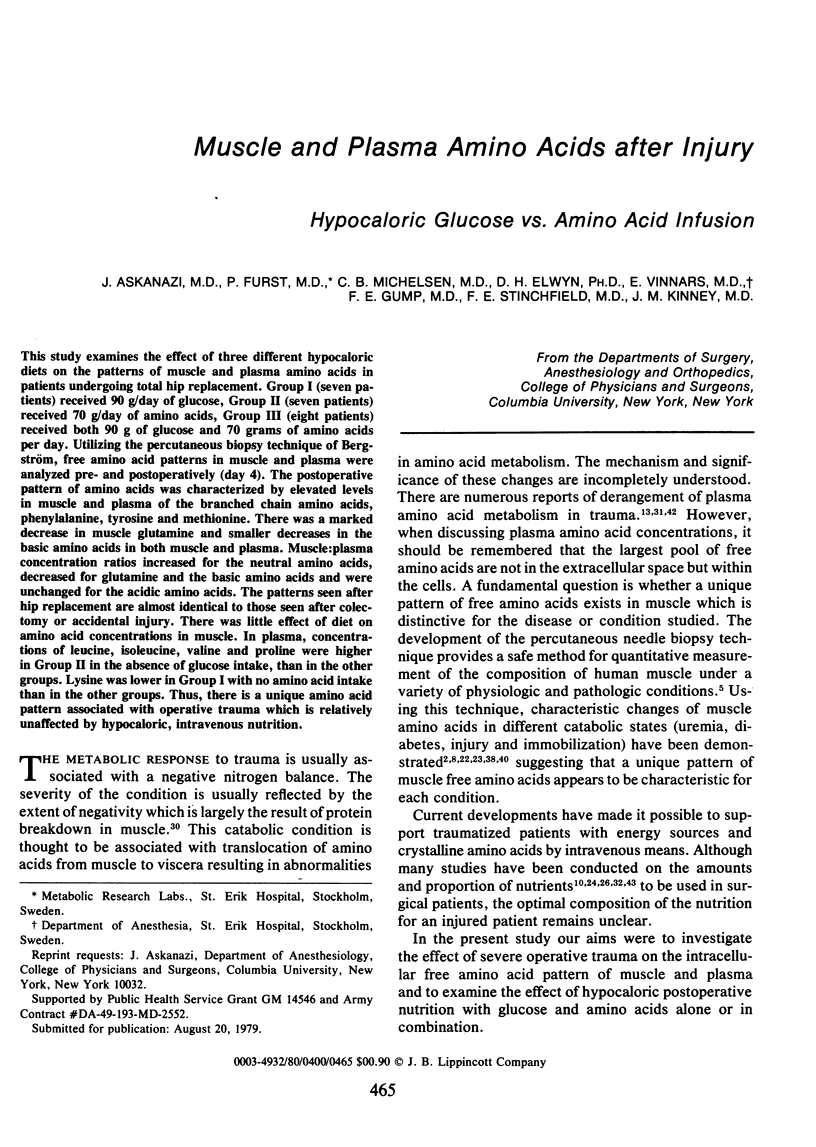
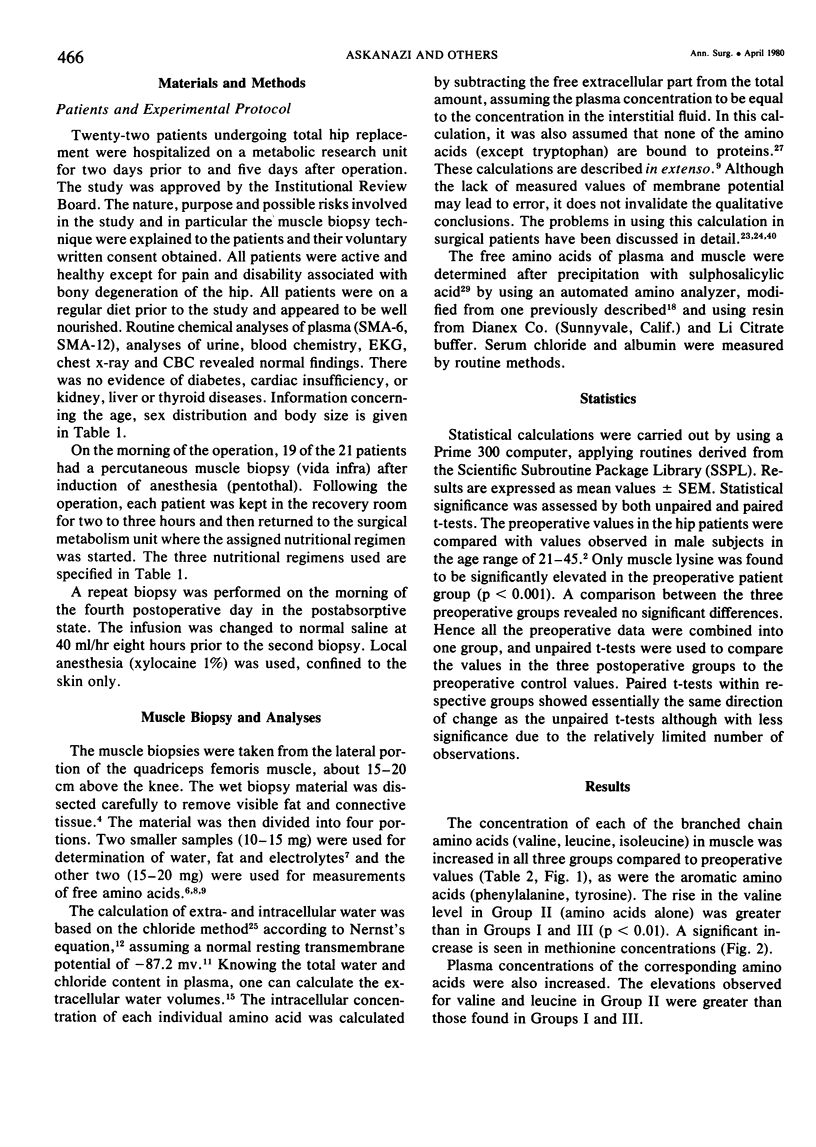
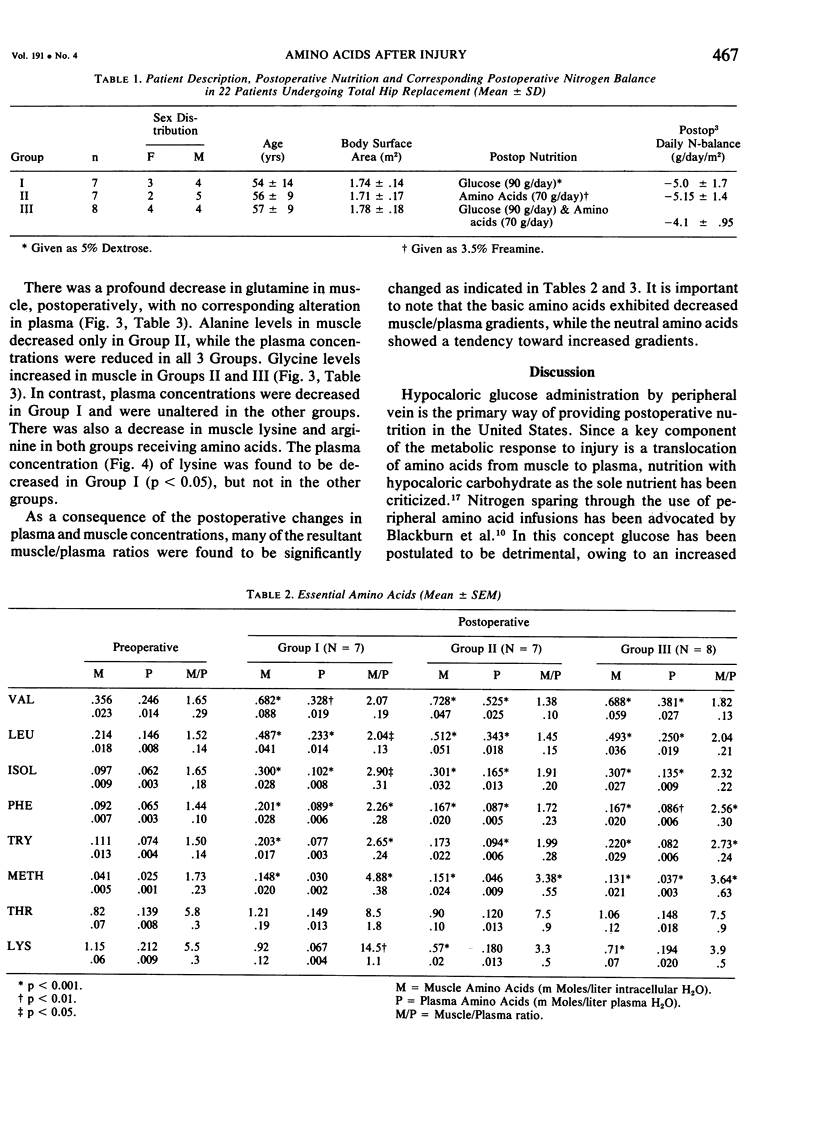
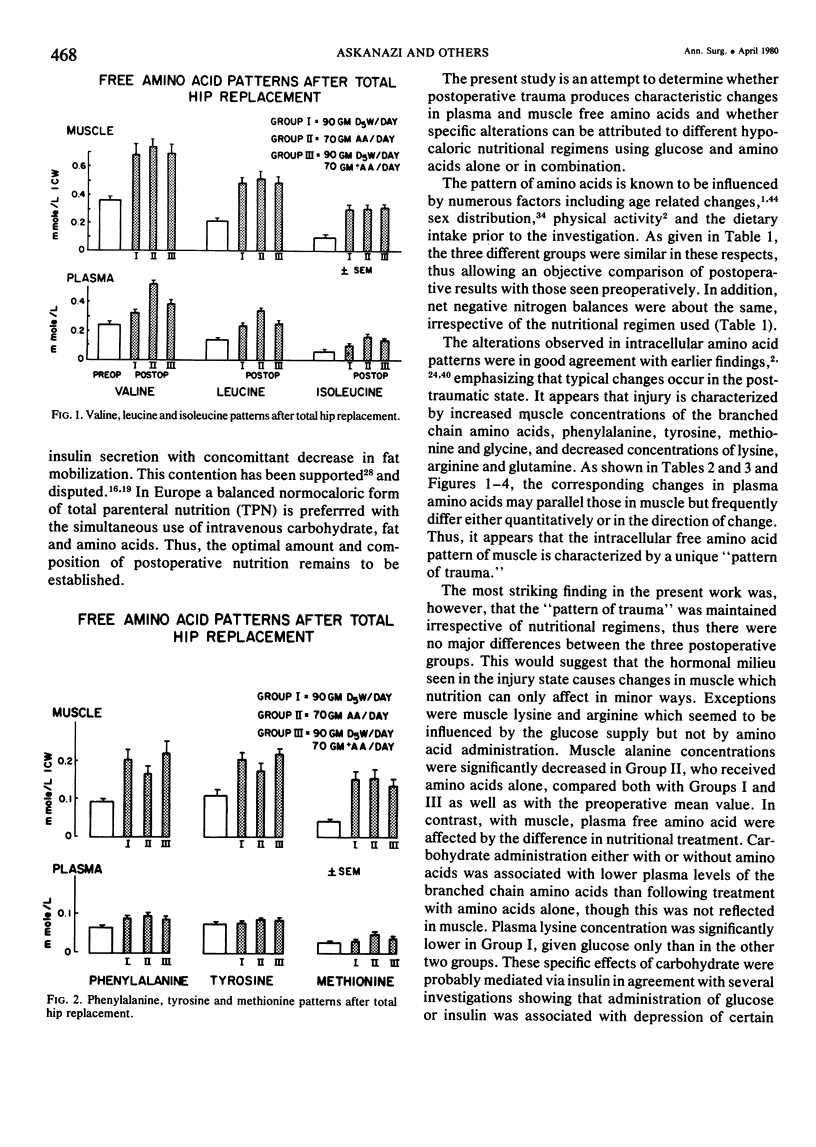
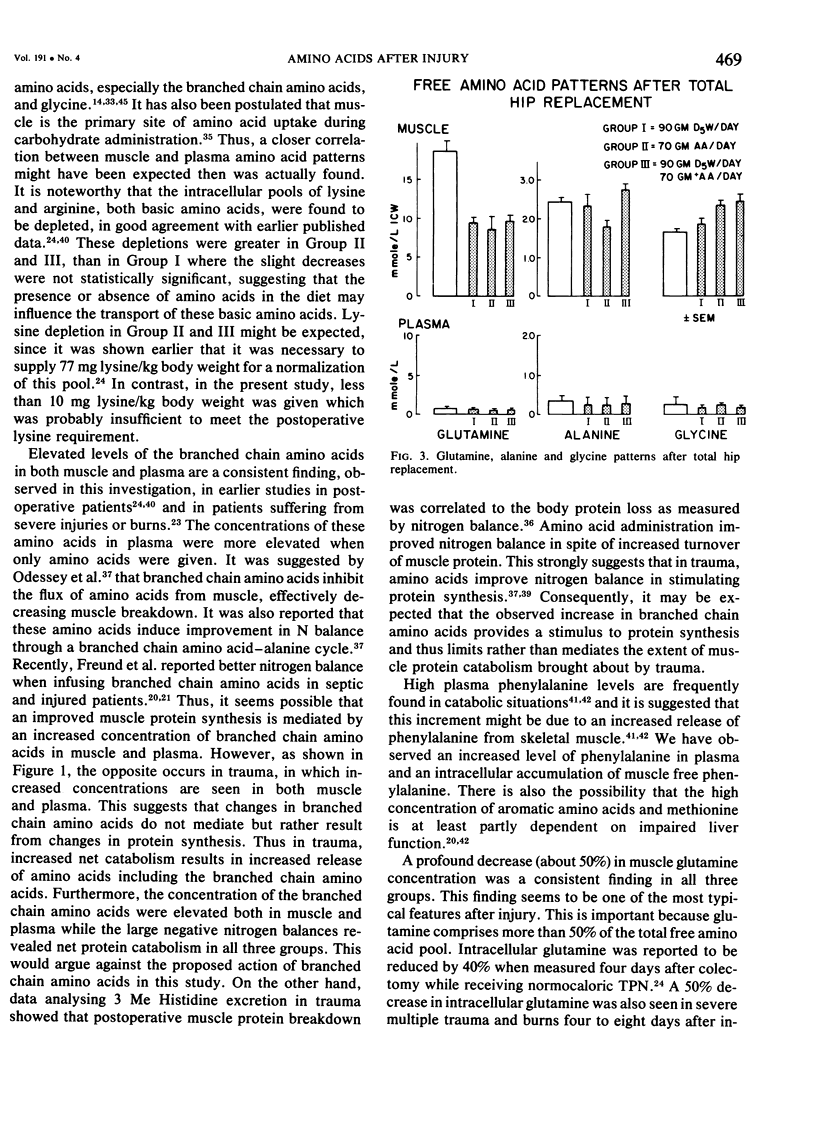
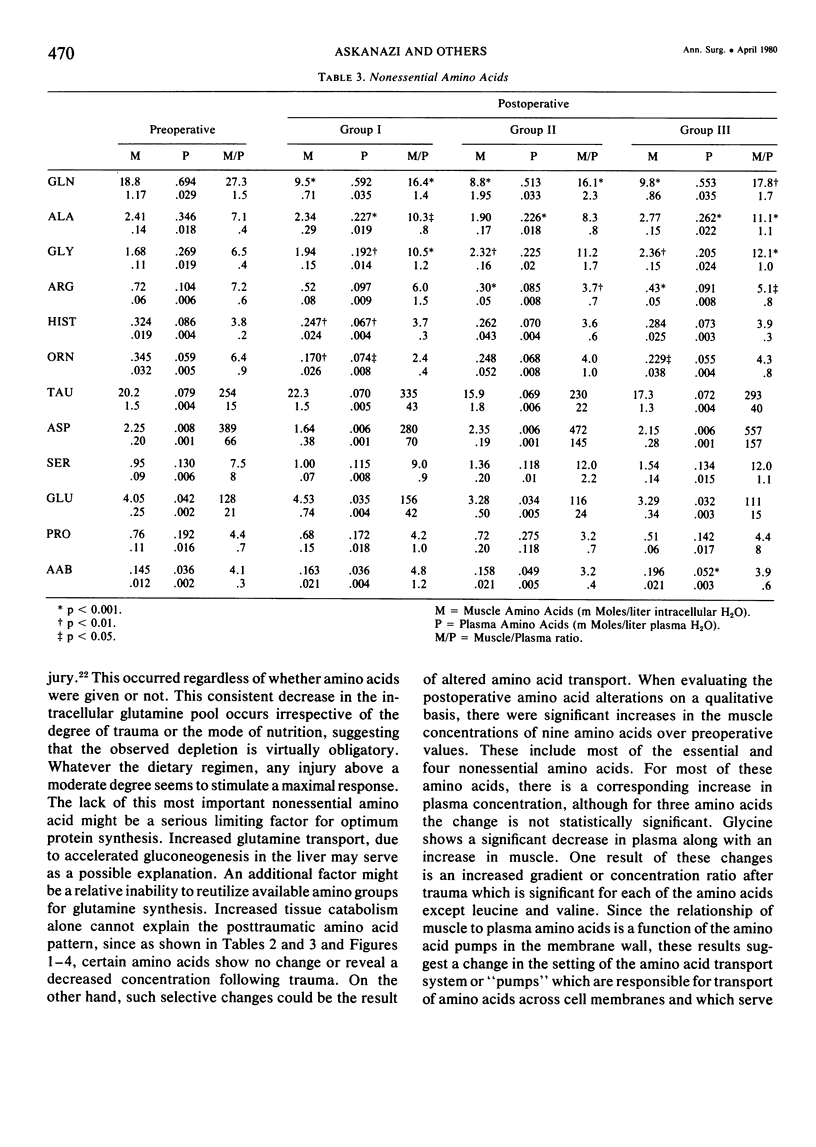
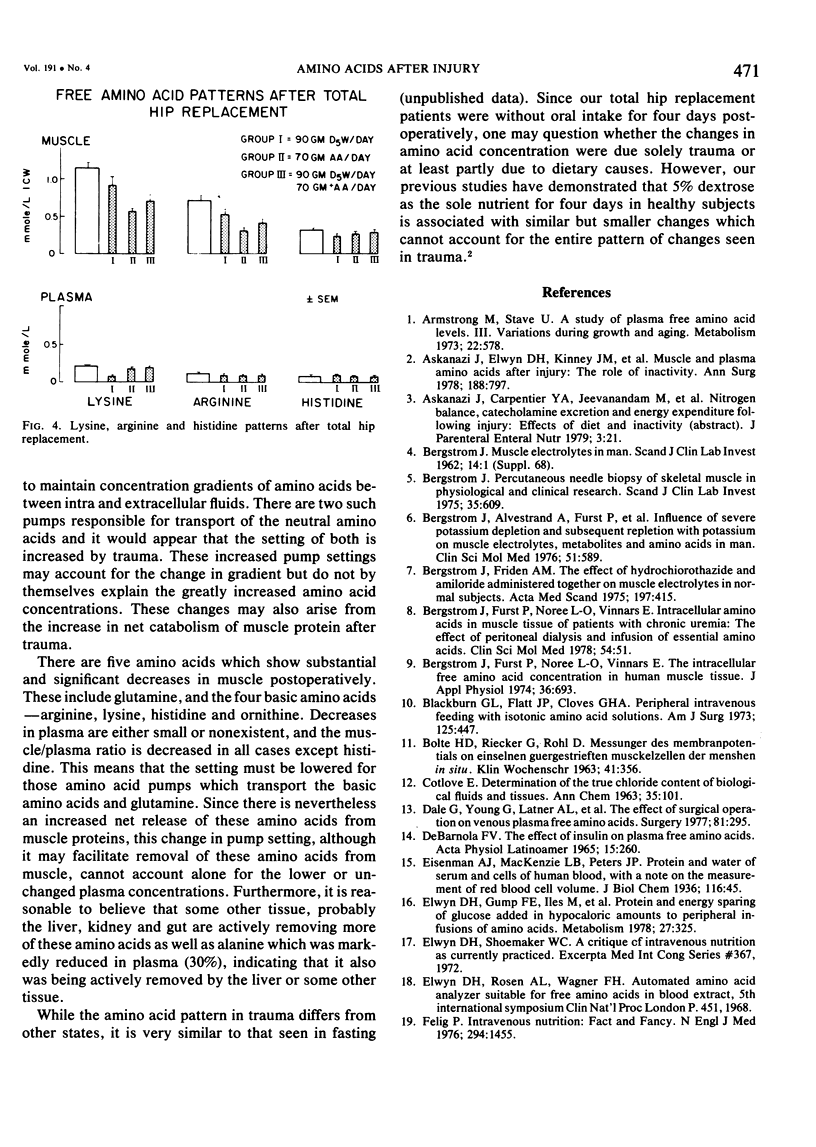
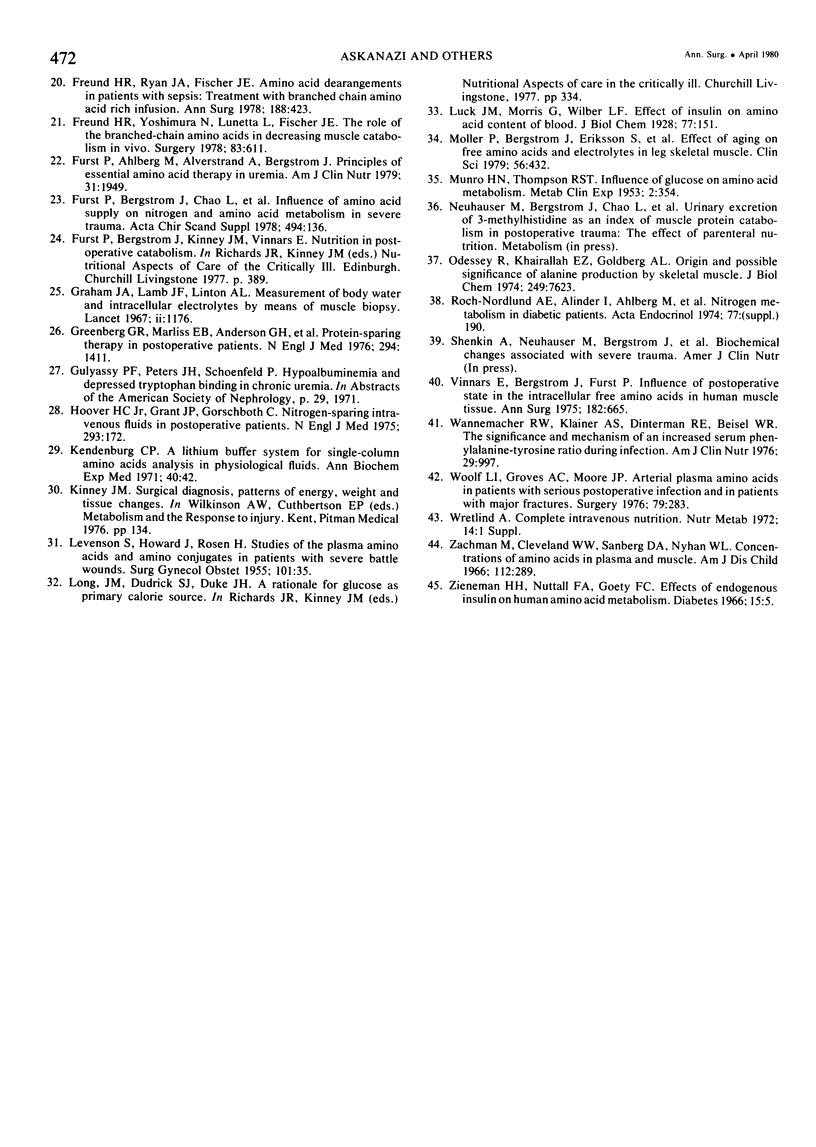
Selected References
These references are in PubMed. This may not be the complete list of references from this article.
- Askanazi J., Elwyn D. H., Kinney J. M., Gump F. E., Michelsen C. B., Stinchfield F. E., Fürst P., Vinnars E., Bergström J. Muscle and plasma amino acids after injury: the role of inactivity. Ann Surg. 1978 Dec;188(6):797–803. doi: 10.1097/00000658-197812000-00014. [DOI] [PMC free article] [PubMed] [Google Scholar]
- BOLTE H. D., RIECKER G., ROHL D. [Measurements of the membrane potential of single cross-striated muscles of man in situ. Normal values]. Klin Wochenschr. 1963 Apr 15;41:356–359. doi: 10.1007/BF01487862. [DOI] [PubMed] [Google Scholar]
- Bergstrom J. Percutaneous needle biopsy of skeletal muscle in physiological and clinical research. Scand J Clin Lab Invest. 1975 Nov;35(7):609–616. [PubMed] [Google Scholar]
- Bergström J., Alvestrand A., Fürst P., Hultman E., Sahlin K., Vinnars E., Widström A. Influence of severe potassium depletion and subsequent repletion with potassium on muscle electrolytes, metabolites and amino acids in man. Clin Sci Mol Med. 1976 Dec;51(6):589–599. doi: 10.1042/cs0510589. [DOI] [PubMed] [Google Scholar]
- Bergström J., Fürst P., Norée L. O., Vinnars E. Intracellular free amino acid concentration in human muscle tissue. J Appl Physiol. 1974 Jun;36(6):693–697. doi: 10.1152/jappl.1974.36.6.693. [DOI] [PubMed] [Google Scholar]
- Bergström J., Fürst P., Norée L. O., Vinnars E. Intracellular free amino acids in muscle tissue of patients with chronic uraemia: effect of peritoneal dialysis and infusion of essential amino acids. Clin Sci Mol Med. 1978 Jan;54(1):51–60. doi: 10.1042/cs0540051. [DOI] [PubMed] [Google Scholar]
- Bergström J. The effect of hydrochlorothiazide and amiloride administered together on muscle electrolytes in normal subjects. Acta Med Scand. 1975 May;197(5):415–419. doi: 10.1111/j.0954-6820.1975.tb04942.x. [DOI] [PubMed] [Google Scholar]
- Blackburn G. L., Flatt J. P., Clowes G. H., O'Donnell T. E. Peripheral intravenous feeding with isotonic amino acid solutions. Am J Surg. 1973 Apr;125(4):447–454. doi: 10.1016/0002-9610(73)90080-9. [DOI] [PubMed] [Google Scholar]
- Dale G., Young G., Latner A. L., Goode A., Tweedle D., Johnston I. D. The effect of surgical operation on venous plasma free amino acids. Surgery. 1977 Mar;81(3):295–301. [PubMed] [Google Scholar]
- De Barnola F. V. The effect of insulin on plasma free amino acids. Acta Physiol Lat Am. 1965;15(3):260–265. [PubMed] [Google Scholar]
- Elwyn D. H., Gump F. E., Lles M., Long C. L., Kinney J. M. Protein and energy sparing of glucose added in hypocaloric amounts to peripheral infusions of amino acids. Metabolism. 1978 Mar;27(3):325–331. doi: 10.1016/0026-0495(78)90112-9. [DOI] [PubMed] [Google Scholar]
- Felig P. Editorial: Intravenous nutrition: fact and fancy. N Engl J Med. 1976 Jun 24;294(26):1455–1456. doi: 10.1056/NEJM197606242942612. [DOI] [PubMed] [Google Scholar]
- Freund H. R., Ryan J. A., Jr, Fischer J. E. Amino acid derangements in patients with sepsis: treatment with branched chain amino acid rich infusions. Ann Surg. 1978 Sep;188(3):423–430. doi: 10.1097/00000658-197809000-00017. [DOI] [PMC free article] [PubMed] [Google Scholar]
- Freund H., Yoshimura N., Lunetta L., Fischer J. E. The role of the branched-chain amino acids in decreasing muscle catabolism in vivo. Surgery. 1978 Jun;83(6):611–618. [PubMed] [Google Scholar]
- Graham J. A., Lamb J. F., Linton A. L. Measurement of body water and intracellular electrolytes by means of muscle biopsy. Lancet. 1967 Dec 2;2(7527):1172–1176. doi: 10.1016/s0140-6736(67)91892-2. [DOI] [PubMed] [Google Scholar]
- Greenberg G. R., Marliss E. B., Anderson G. H., Langer B., Spence W., Tovee E. B., Jeejeebhoy K. N. Protein-sparing therapy in postoperative patients. Effects of added hypocaloric glucose or lipid. N Engl J Med. 1976 Jun 24;294(26):1411–1416. doi: 10.1056/NEJM197606242942601. [DOI] [PubMed] [Google Scholar]
- Hoover H. C., Jr, Grant J. P., Gorschboth C., Ketcham A. S. Nitrogen-sparing intravenous fluids in postperative patients. N Engl J Med. 1975 Jul 24;293(4):172–175. doi: 10.1056/NEJM197507242930404. [DOI] [PubMed] [Google Scholar]
- Kedenburg C. P. A lithium buffer system for accelerated single-column amino acid analysis in physiological fluids. Anal Biochem. 1971 Mar;40(1):35–42. doi: 10.1016/0003-2697(71)90081-9. [DOI] [PubMed] [Google Scholar]
- LEVENSON S. M., HOWARD J. M., ROSEN H. Studies of the plasma amino acids and amino conjugates in patients with severe battle wounds. Surg Gynecol Obstet. 1955 Jul;101(1):35–47. [PubMed] [Google Scholar]
- MUNRO H. N., THOMSON W. S. Influence of glucose on amino acid metabolism. Metabolism. 1953 Jul;2(4):354–361. [PubMed] [Google Scholar]
- Möller P., Bergström J., Eriksson S., Fürst P., Hellström K. Effect of aging on free amino acids and electrolytes in leg skeletal muscle. Clin Sci (Lond) 1979 May;56(5):427–432. doi: 10.1042/cs0560427. [DOI] [PubMed] [Google Scholar]
- Odessey R., Khairallah E. A., Goldberg A. L. Origin and possible significance of alanine production by skeletal muscle. J Biol Chem. 1974 Dec 10;249(23):7623–7629. [PubMed] [Google Scholar]
- Vinnars E., Bergstöm J., Fürst P. Influence of the postoperative state on the intracellular free amino acids in human muscle tissue. Ann Surg. 1975 Dec;182(6):665–671. doi: 10.1097/00000658-197512000-00001. [DOI] [PMC free article] [PubMed] [Google Scholar]
- Wannemacher R. W., Jr, Klainer A. S., Dinterman R. E., Beisel W. R. The significance and mechanism of an increased serum phenylalanine-tyrosine ratio during infection. Am J Clin Nutr. 1976 Sep;29(9):997–1006. doi: 10.1093/ajcn/29.9.997. [DOI] [PubMed] [Google Scholar]
- Woolf L. I., Grovers A. C., Moore J. P., Duff J. H., Finley R. J., Loomer R. L. Arterial plasma amino acids in patients with serious postoperative infection and in patients with major fractures. Surgery. 1976 Mar;79(3):283–292. [PubMed] [Google Scholar]
- Zachmann M., Cleveland W. W., Sandberg D. H., Nyhan W. L. Concentrations of amino acids in plasma and muscle. Relationship to androgen metabolism during growth and development in the male. Am J Dis Child. 1966 Oct;112(4):283–289. doi: 10.1001/archpedi.1966.02090130057004. [DOI] [PubMed] [Google Scholar]
- Zinneman H. H., Nuttall F. Q., Goetz F. C. Effect of endogenous insulin on human amino acid metabolism. Diabetes. 1966 Jan;15(1):5–8. doi: 10.2337/diab.15.1.5. [DOI] [PubMed] [Google Scholar]


